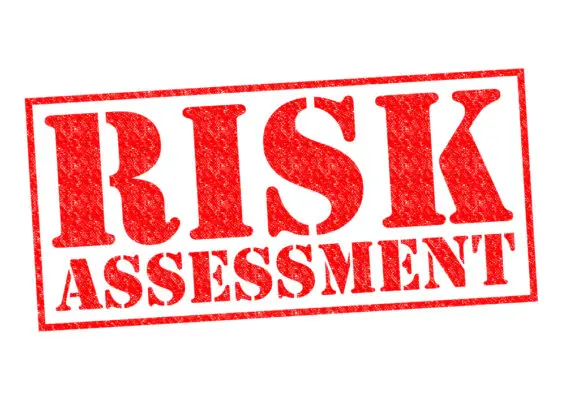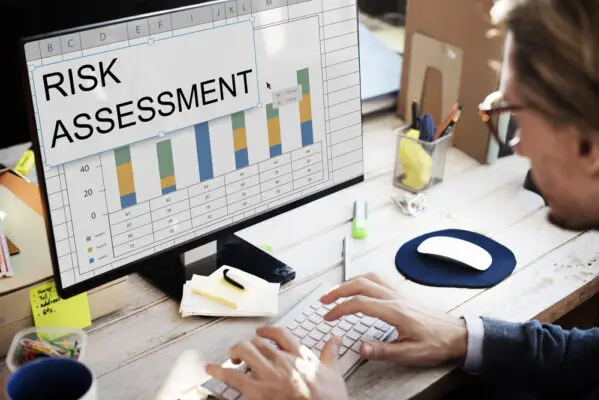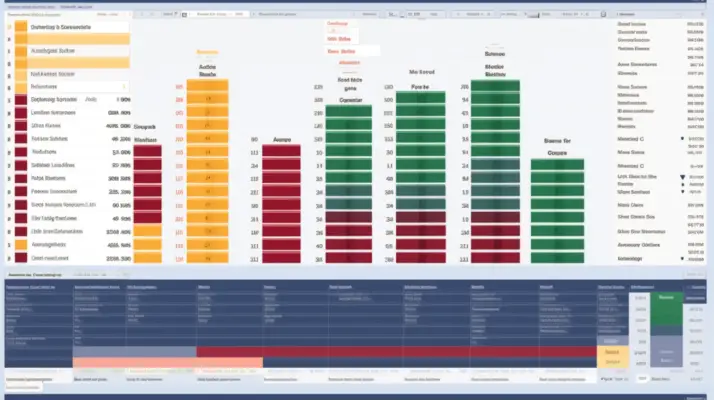LMRA identifies and evaluates potential dangers and risks that may appear in a situation or environment shortly before it occurs. The importance of LMRA lies in its ability to guarantee the safety and well-being of those involved, as it enables them to make informed decisions and implement the necessary control measures.
This article will discuss the definition of LMRA, its importance, and the steps necessary for developing a last-minute risk assessment plan. Additionally, it will touch on the role of coaching in facilitating effective last-minute risk assessments.

Definition of Last-Minute Risk Assessment
Last-minute assessment, or last-minute risk analysis, refers to evaluating potential risks and hazards that may arise in a given situation or project at the last minute.
It involves identifying and analyzing any new or unforeseen risks not previously considered and reassessing the existing risks in light of new information.
Last-minute risk is of utmost importance as it allows organizations to anticipate and mitigate potential risks that could significantly impact the success or safety of a project or activity.
Conducting a thorough assessment, organizations can effectively manage and minimize risks, ensuring the smooth execution of their plans and the safety of the individuals involved.
Importance of Last-Minute Risk Assessment
The importance of conducting a last-minute assessment lies in its ability to comprehensively evaluate potential risks and enable effective mitigation strategies. By assessing risks in real time, organizations can identify any unforeseen hazards or changes in conditions that may threaten safety.
This enables them to take immediate measures to address these risks and ensure the individuals’ well-being. Furthermore, a last-minute assessment allows for critical questions to be asked regarding the safety of the situation, the adequacy of communication and instructions, and the suitability of equipment.
It also provides an opportunity to reassess the overall situation and make necessary adjustments to ensure a safe working environment. Ultimately, a last-minute risk assessment is vital in enhancing situational awareness and fostering a proactive approach toward risk management.
Understanding Last-Minute Risk Assessment
Potential risks must be identified and evaluated in a last-minute situation to make informed decisions.
Two-way communication is essential for effective last-minute risk assessments, as it allows for exchanging information and perspectives between different stakeholders.
Criteria for last-minute risk assessments should be established to ensure consistency and objectivity in decision-making.
Understanding the current situation is crucial for conducting a last-minute risk assessment, as it provides the necessary context and information for evaluating potential risks and determining appropriate actions.
Potential Risks in a Last-Minute Situation
Potential risks in a last-minute situation include inadequate preparation, limited time for thorough analysis, and the potential for overlooking critical factors. Identifying and understanding the potential risks in such situations becomes crucial to manage them effectively.
One way to achieve this is through an assessment team that can assess the current situation and determine its potential risks. This team can employ various risk assessment methods to evaluate the likelihood and impact of each risk.
Additionally, two-way communication between the team and relevant stakeholders is essential to ensure a comprehensive understanding of the risks and to gather valuable input. By considering the location, previous incidents, and other relevant factors, a thorough and detailed assessment can be conducted, enabling effective risk management and the development of appropriate strategies to mitigate potential risks.
| Location | Incidents | Potential Risks |
|---|---|---|
| City A | 3 | High |
| City B | 1 | Moderate |
| City C | 2 | Low |
Table 1: Examples of potential risks in different locations based on previous incidents.
Two-Way Communication for Last-Minute Risk Assessments
- Development of mitigation strategies.
- Alignment with established criteria and guidelines.
- Engagement of all stakeholders in the risk assessment process.
- Fostering collaboration and informed decision-making processes.
- Promoting a commitment to safety.
Criteria for Last-Minute Risk Assessments
One important aspect to consider when conducting a rapid evaluation of potential hazards is establishing specific criteria to guide the assessment process.
These criteria serve as a framework for identifying and evaluating risks, ensuring that all relevant factors are considered. By defining the criteria of assessment, organizations can ensure consistency and objectivity in their evaluations.
To provide a deeper understanding of the criteria for last-minute assessments, a table is provided below:
| Criteria | Description | Examples |
|---|---|---|
| Risk Behaviors | Identifying actions or behaviors that increase the likelihood of risks | Not wearing personal protective equipment |
| Quality of Risk Assessment | Evaluating the accuracy and effectiveness of the risk assessment process | Adequate documentation and analysis of risks |
| Risk Assessment Orientation | Determining the focus of the assessment, such as prevention or mitigation | Identifying potential hazards in a construction site |
| Risk Management Tools | Utilizing tools and techniques to assess and manage risks | Risk matrices and decision trees |
| Additional Risks | Considering unforeseen risks that may arise during the assessment | Changes in weather conditions or equipment malfunction |
Organizations can ensure more thorough evaluations by incorporating these criteria into last-minute risk assessments. This will enable them to make informed decisions and implement appropriate measures to mitigate risks effectively.
It is also important to note that expert assessment skills and feedback on risk assessments play a significant role in improving the overall quality of the assessment process.
Understanding the Current Situation for a Last-Minute Risk Assessment
Understanding the immediate context is crucial for the timely evaluation of potential hazards. To support the current assessment, several factors need to be considered:
- Conducting risk assessments: It is essential to have a clear understanding of the process and steps involved in conducting risk assessments. This includes identifying potential risks, assessing their likelihood and severity, and implementing appropriate control measures.
- Employee risk assessment skills: The competency of employees in conducting risk assessments plays a significant role in ensuring the accuracy and effectiveness of the assessment. Proper training and development measures should be in place to enhance their skills.
- Effective risk assessment methods: Utilizing reliable and validated risk assessment methods is essential for obtaining accurate results. These methods should consider the specific nature of the task or environment being assessed.
- Existing instructions and corrective actions: Examining existing instructions, incident reports, and corrective actions can provide valuable insights into potential hazards and dangerous conditions. This information can guide the risk assessment process and help identify areas for improvement in control measures.
Considering these factors, a comprehensive and accurate last-minute risk assessment can be conducted, ensuring the safety of employees and the prevention of potential hazards.

Developing a Last-Minute Risk Assessment Plan
First, forming a team for the assessment is crucial to ensure that different perspectives and expertise are considered.
Next, identifying and analyzing risks and behaviors is essential to understand the potential hazards and their impact on the project.
Developing tools to manage hazards and risks is important for effective risk mitigation.
It is also important to consider activities without risks identified in the processes and any additional risks that may emerge.
Forming a Team for the Risk Assessment
To ensure a comprehensive and rigorous risk assessment, assembling a high-performing team with diverse expertise and experience is crucial.
This team should include individuals who have a deep understanding of the concepts of risk assessment and expertise in conducting formal job safety analyses or hazard assessments. Additionally, team members should possess a strong safety awareness and the ability to communicate and collaborate with others effectively.
Coaching on risk assessment and training activities can be implemented to develop a successful risk assessment team. These activities should focus on effective training methods and developing communication skills. By providing the necessary training and coaching, team members can enhance their understanding of risk assessment and improve their ability to identify and mitigate potential risks.
Furthermore, development actions such as team-building exercises and regular meetings can foster a collaborative and supportive environment within the team. This will encourage open discussions and sharing of ideas and insights, ultimately leading to a more thorough and detailed risk assessment process.
Identifying and Analyzing Risks and Behaviors
Identifying and analyzing potential risks and behaviors is essential in conducting a thorough and effective risk assessment. In the context of last-minute risk assessments, it becomes even more crucial to identify any electrical risks that may be present in the environment.
This includes assessing the safety of electrical equipment and systems and evaluating potential hazards such as faulty wiring or overloaded circuits. Additionally, environmental risks should be taken into consideration, such as the presence of hazardous materials or unsafe working conditions.
It is important to ensure the wholeness of safety practices by adhering to relevant regulations and guidelines, such as the Finnish Occupational Health and Safety Act. Furthermore, the assessment should encompass the actual safety theme, emphasizing the care of safety in every aspect of the task or project.
This can be achieved through extra safety checks and the implementation of formal job safety analysis or hazard assessment procedures, such as using a hazard assessment control form or conducting a semistructured interview form with relevant personnel.
Considering these factors, a comprehensive analysis of risks and behaviors can be conducted to mitigate potential hazards and ensure a safe working environment.
Development of Tools to Manage Hazards and Risks
One effective approach to ensure the mitigation of potential hazards and risks is through the development of specialized tools and resources. Providing a structured framework for risk assessment, these tools enable companies to:
1) Contextual Analysis: One important aspect of tool development is the ability to analyze risks within the specific context of the company or industry. This involves understanding the unique challenges and vulnerabilities and tailoring the tools to address these needs.
2) Relevant Information: Effective tools for risk assessment should provide access to relevant information and data. This may include historical data on past incidents, industry standards, and best practices, and current research and trends. By providing access to this information, the tools enable companies to make informed decisions about risk management.
3) Forms and Templates: Tools often include pre-designed forms and templates to facilitate the risk assessment. These forms provide a standardized approach to collecting and documenting risk information, ensuring consistency and completeness in the assessment process.
They also help streamline risk analysis and reporting, making it easier for companies to track and monitor their risk management efforts.
Developing specialized tools and resources is essential for effective risk assessment and management. These tools enable companies to analyze risks within their context, provide access to relevant information, and streamline the assessment process using forms and templates.
Companies can better identify and mitigate potential hazards and risks by incorporating these tools into their risk management practices.
Activities Without Risks Identified in the Processes
Activities performed in the processes may not always involve identified risks, indicating that some tasks may be considered inherently safe or have minimal potential for harm.
However, it is crucial for formal job safety analysis to be conducted to ensure that all potential hazards and risks are adequately assessed. This analysis should consider the current conditions, such as adverse weather conditions or inadequate visibility conditions, which may increase the likelihood of accidents or incidents.
Insurance companies and industrial companies often require this analysis to be carried out to mitigate potential liabilities.
Moreover, it is important to note that unwritten instructions or inconsistent processes can contribute to dangerous situations, even in perceived safety activities. Therefore, a comprehensive hazard assessment should be conducted to identify and manage any potential risks, regardless of the perceived safety of the activity.
Additional Risks That May Emerge During the Process
Additional risks that may emerge during the process include unforeseen equipment malfunctions or failures, changes in environmental conditions, and human error. These risks can have significant consequences on the safety of individuals and the success of the task at hand.
To effectively manage these risks, it is important to conduct a thorough job safety analysis and hazard assessment before the start of the activity. This will help identify potential risks and develop appropriate mitigation control measures.
Regular equipment inspection and maintenance can also reduce the likelihood of equipment malfunctions or failures. Training transfer is crucial to ensure individuals have the necessary knowledge and skills to handle potential risks.
Furthermore, controlling environmental factors such as heat stress through proper measures and considering both chemical and human factors can contribute to a safer working environment.
Interviews and open-ended questions can gather insights and further identify potential risks. By addressing these additional risks, organizations can enhance their activities’ overall safety and success.
| Risk Factors | Mitigation Measures |
|---|---|
| Equipment malfunctions or failures | Regular equipment inspection and maintenance |
| Changes in environmental conditions | Implementing heat stress control measures |
| Human error | Proper training and job safety analysis |
Coaching on Last Minute Risk Assessments
Last-minute risk assessments involve thoroughly evaluating potential risks and hazards that may arise unexpectedly. These assessments are typically carried out in situations with limited time to prepare and plan for potential risks, such as during emergencies or unforeseen events.
A last-minute risk assessment aims to identify and prioritize potential risks to develop effective strategies for mitigating them. This process requires quick thinking and decision-making skills and the ability to gather and analyze information rapidly.
Coaching on last-minute risk assessments can help individuals and teams develop the necessary skills and knowledge to assess and manage risks in high-pressure situations effectively.
Coaching sessions may focus on teaching individuals how to quickly identify potential risks, gather relevant information, and assess the severity and likelihood of each risk. Participants can also learn strategies for prioritizing risks and developing contingency plans. Additionally, coaching can guide effective communication and decision-making during last-minute risk assessments.
Receiving coaching on last-minute risk assessments, individuals and teams can enhance their ability to respond effectively to unexpected risks and hazards. This can help minimize the potential negative impacts of unforeseen events and improve safety and preparedness.
Concepts of Last-Minute Risk Assessments
- A comprehensive understanding of the fundamental principles underlying the concepts of last-minute risk assessments is crucial for effective risk management.
- Conducting a hazard assessment before undertaking any tasks is essential to ensure a formal job safety analysis.
- Video training can educate workers on the proper procedures and protocols.
- Open-ended questions can be posed to workers to encourage them to think critically about potential risks and hazards.
- An automatic location and incident reporting platform can be implemented to streamline the process of risk assessment and reporting.
- Regular inspections should be carried out to identify and address any potential hazards.
- Organizations can minimize workplace accidents and injuries by grasping the concepts of last-minute risk assessments, enhancing overall safety and productivity.
Frequently Asked Questions
What are the potential consequences of not conducting a last-minute risk assessment?
Not conducting a last-minute risk assessment can lead to unidentified risks, increased likelihood of accidents or incidents, financial losses, damage to reputation, legal liabilities, and compromised safety of individuals and the environment.
How can employees effectively communicate their concerns during a last-minute risk assessment?
Employees can effectively communicate their concerns during a last-minute risk assessment by providing clear, concise explanations, supporting their claims with evidence or data, and suggesting alternative strategies or actions to mitigate the identified risks.
What are some common challenges when developing a last-minute risk assessment plan?
Common challenges in developing a risk assessment plan include time constraints, limited availability of resources, difficulty in obtaining accurate information, and the need for quick decision-making. These factors may impact the thoroughness and effectiveness of the assessment.
Are there any legal requirements or regulations pertaining to last-minute risk assessments?
Legal requirements and regulations for risk assessments exist to ensure the safety and well-being of individuals and organizations. These requirements may vary depending on the industry and jurisdiction, but they generally emphasize the importance of identifying and mitigating potential risks in a timely manner.
How can organizations consistently implement last-minute risk assessments across different departments or projects?
Organizations can ensure consistency in implementing risk assessments across different departments or projects by establishing standardized procedures, providing clear guidelines, conducting regular training sessions, and promoting effective communication and collaboration among stakeholders.

Conclusion
Last-minute risk assessment is a crucial process that allows organizations to identify and address potential risks that may arise unexpectedly.
It involves evaluating the likelihood and severity of risks and developing strategies to mitigate them effectively.
Developing a last-minute risk assessment plan involves thoroughly analyzing the current situation, considering various factors contributing to the risks, and creating a comprehensive action plan.
Additionally, coaching on last-minute risk assessments can be provided to employees to enhance their understanding and skills in identifying and managing risks.

Chris Ekai is a Risk Management expert with over 10 years of experience in the field. He has a Master’s(MSc) degree in Risk Management from University of Portsmouth and is a CPA and Finance professional. He currently works as a Content Manager at Risk Publishing, writing about Enterprise Risk Management, Business Continuity Management and Project Management.

